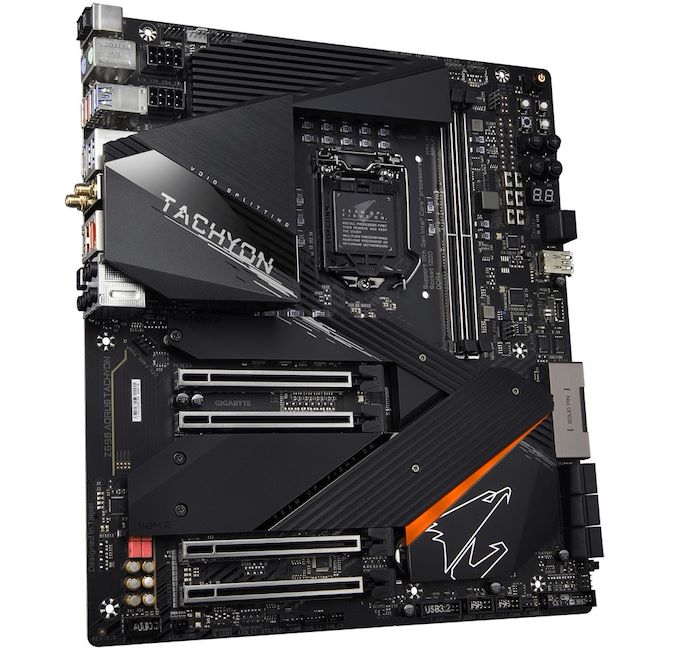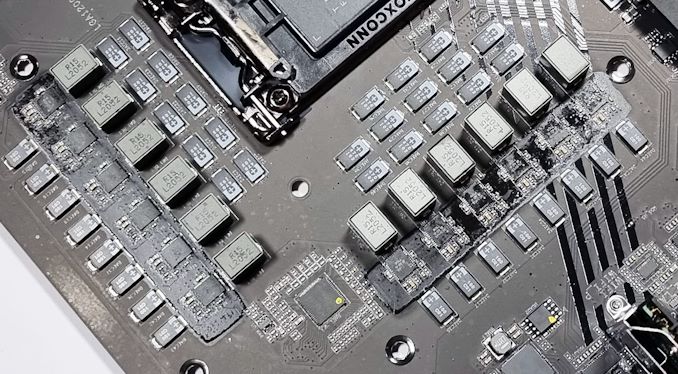GIGABYTE Z590 Aorus Tachyon Review: Built for SPEED
by Gavin Bonshor on May 10, 2021 9:30 AM ESTConclusion: This Board Clocks
Over the last month or so in our previous Z590 reviews, we've highlighted that to get the most out of Intel's unlocked Core K and KF 11th gen processors, the Z590 chipset is the go-to for performance users. Going beyond Intel's own integrated overclocking technologies, including both Thermal Velocity Boost (TVB) and Adaptive Boost Technology (ABT), requires adequate and quality hardware, but going beyond that with extreme cooling methods such as liquid nitrogen (LN2) requires the more premium products. While most users won't be looking at this space, it's where boards such as the GIGABYTE Z590 Aorus Tachyon enter the mix, with intricate and focused designs focused on benchmarking, both from a firmware and hardware point of view.
The GIGABYTE Z590 Aorus Tachyon is primarily designed for extreme overclockers looking to maximize both CPU and memory performance under sub-zero cooling methods. A lot of the design choices point directly to this. The two memory slots, which GIGABYTE has purposely located closer to the CPU socket, are designed to reduce latency penalties. The design includes shielded memory routing of the circuitry connecting the slots to the CPU socket. This is hidden under an inner layer of PCB which uses a larger ground layer that is designed to protect the signal from interference from external sources.
Another element that favors extreme overclockers is the CPU socket, with an array of Tantalum Polymer Capacitors, which inherently have a flatter design than other types of capacitors, making the mounting of pots used in sub-zero cooling methods easier to mount. Looking at the PCIe slot array, this also favors extreme overclockers looking to push limits on graphics cards, with two banks of full-length slots, the top two operating at PCIe 4.0 x16 and x8/x8, and the bottom two electronically locked down to PCIe 3.0 x4 and x1. The layout of these slots uses single slot spacing, which is consistent with an optimized design for extreme overclocking.
Focusing on the core features associated with the controllers used and chipset options, the Z590 Aorus Tachyon includes a solid networking array consisting of an Intel I225-V 2.5 GbE Intel AX210 Wi-Fi 6E CNVi. Other notable connectivity options include a single USB 3.2 G2x2 Type-C port on the rear panel and three USB 3.2 G2 Type-A and four USB 3.2 G1 Type-A ports. Users looking to add more Type-C connectivity can use the USB 3.2 G2 Type-C front panel header. For storage, the Tachyon has three M.2 slots, with one of these allowing for high-speed NVMe PCIe 4.0 x4 drives and the other two with both PCIe 3.0 x4 and SATA support. In terms of conventional storage, there's a total of eight SATA ports, with six controlled by the chipset with RAID 0, 1, 5, and 10 support, while the other two are operating from an ASMedia ASM1061 SATA controller.
In our performance testing, the Z590 Aorus Tachyon was competitive in our system tests, with some of the most efficient power consumption in all three tested states from all the boards we've tested so far. In our non-UEFI POST time test, the Tachyon was one of the quickest boards on test, with adequate performance in DPC latency. Our compute section of our test suite saw very competitive performance at default settings, with solid single-threaded performance results in Cinebench R23 and competitive multi-threaded performance.
Perhaps the bread and butter of the results came in our overclocking experience, with solid under-compensation of CPU VCore at full load, which as a direct result reduced overall CPU core temperatures and power consumption. The Tachyon also managed to run our Core i9-11900K at 5.3 GHz all-core stable, which is the first Z590 board we've tested so far to do this. Equipped with a direct 12-phase power delivery that operates with two PWM controllers, the CPU at 11+0 and SoC at 1+0, both elements are using Vishay SiC430 100 A power stages, which seems to point to a very efficient power delivery design. Our VRM thermal testing also confirms this with solid temperatures across the board, although we have to note that so far in our VRM thermal testing on Z590, many of the boards tend to dump a lot of the heat into the power plane of the power delivery.
Final Thoughts
The GIGABYTE Z590 Aorus Tachyon offers both elements for gamers and content creators, but it should be noted that to benefit most from the features and functionality, it would require sub-zero cooling. There's plenty for typical users including Intel 2.5 GbE, Wi-Fi 6E, and USB 3.2 G2x2 Type-C connectivity, but the overall design offers much more for extreme overclockers including the design layout, the premium power delivery, and as such, displayed some fantastic results in our overclocking testing. There's not much in the way of competition with the two main rivals, the ASRock Z590 OC Formula and ASUS ROG Maximus XIII Apex, both offering similar feature sets and containing a similar extreme pedigree. For enthusiasts and extreme overclockers, the Tachyon is a shining example of an extreme motherboard done correctly, but for the average joe, there's much more value in other Z590 options due to the large $530 price tag.
Overall, this board enables regular users to get the best out of their CPU, however paying the premium for that might not be a cost effective investment. Users who get the Tachyon will want the best of everything out of their processor. That's why extreme overclockers will fully enjoy the Tachyon.
We're set to use the Tachyon in an upcoming overclock comparison with some sub-zero cooling on a number of 11900K CPUs. Stay tuned for that review.












15 Comments
View All Comments
Linustechtips12#6900xt - Monday, May 10, 2021 - link
I do hope in the pursuit of faster memory, the consumer boards still have 4 ram slots, I had 16GB and I just upgraded to 32Gb with the 2 slots I had free, it creates less e-waste too imo.MenhirMike - Monday, May 10, 2021 - link
I don't see a reason for regular consumer boards to move away from 2 DIMMs per Channel/4 DIMMs on a Desktop board. This board is for extreme overclocking, where only having 2 DIMMs makes a lot of sense (shorter trace lengths mean that the likelyhood for a successful overclock increase).Silver5urfer - Tuesday, May 11, 2021 - link
e-waste ? lol. That is over at the BGA garbage use and throw laptops where the battery cannot be purchased and the Heatsink will deteriorate due to poor cooling and ultimately the laptop will be rendered useless garbage.Or the li-ion phones that are announced every year, Apple says they sell double digit millions every quarter so what happened to the millions for the past year or such, same for Android li-ion sealed phones.
Or those new wireless earbuds which do not have any option to replace the battery in them and every year people purchase new esp Anker and the low end market is literally flooded by these use and throw garbage products.
Desktop DRAM DIMM slots do not have any relationship with e-waste in contrast with the other consumer products which are made for planned obsolescence plus a Desktop will live as long as the components are in working state, people even run Core 2Quad machines today, and Xeon market still exists since Nehalem uarch machines.
Linustechtips12#6900xt - Wednesday, May 19, 2021 - link
I meant that it creates e wast of dimms not much but it does when you have to throw away a 2*4gb kit because you dont have enough dimm slots and want to upgrade to 16gbmeacupla - Tuesday, May 11, 2021 - link
???consumer boards are unlikely to move away from 4 slots
You do realize that this mobo is specifically designed with very short traces between cpu and ram, right?
Linustechtips12#6900xt - Wednesday, May 19, 2021 - link
i do understand that yes. but its. cost saving thing aswell and it might catch on into consumerdotes12 - Monday, May 10, 2021 - link
I've always wondered why every picture of direct LN2 cooling I've seen is done in wide open air as towels and conformal coatings are used in an attempt to prevent electrical shorts. Why don't we see them putting their board in a glass or plexiglass box (like a fish tank) with a loosely fitting easily removable lid on it? Most compressed (or liquid) gasses are incredibly dry and have extremely low moisture content, so once it turns to gas and displaces the room air from the box it'll naturally be such a low humidity that you shouldn't have to worry about condensation. Furthermore, they could purge the box with another cheap heavy dry gas like CO2 first, or continually pump it in there to keep the moist room air out.gavbon - Monday, May 10, 2021 - link
One of the reasons why an enclosed space would be a negative is that even small amounts of air that would be present can still have moisture. This would condensate on the board and create shorts. Unless you were able to remove ALL traces of the air, it just would cause problems. Also as an ex-extreme overclocker myself, having direct and unrestricted access to the board/pots for heating up the LN2 pot with a blowtorch when hitting a cold bug would be hard to do otherwise.dotes12 - Tuesday, May 11, 2021 - link
That makes sense, thank you for taking the time to write me a reply!just_passin_by_2 - Tuesday, May 24, 2022 - link
A large ventilation to the outside would also be beneficial to prevent a lack of breathable oxygen in the room if using CO2 or liquid nitrogen. Glass could also break especially if under stress from temperature differences. With that said, safety could be dependent on different factors and too much safety could be bad as well. Wearing gloves around liquid nitrogen could potentially allow the liquid nitrogen to become trapped inside the glove to going gloveless may be better but I do not really know. Anyway, this does sound fun and I wish you all the best if anyone here overclocks.